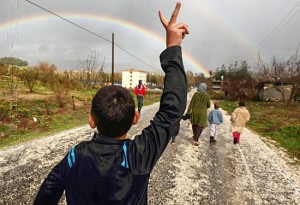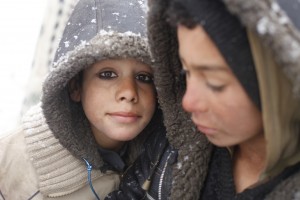
The relationship of migration to non-affective, schizophrenia-like psychosis has been a key question in epidemiological studies of mental illness. Migrants have higher rates of non-affective psychosis but the causes are complex and include both push factors (making it more likely for someone developing a paranoid illness to choose to leave their country of origin) and also post-migration factors that might include social isolation, stigma and a range of other psychosocial stressors.
A new study published today in the BMJ sought to clarify the relationship further by comparing rates of non-affective psychosis in the Swedish population by comparing native-born Swedes (88.4% of sample) to refugee (1.8%) and non-refugee migrants (9.8%) coming from 4 different parts of the world. The Swedish population database gives a unique opportunity to gather information on large numbers.
Existing studies on forced/refugee migrant populations have highlighted the increased prevalence of depressive disorders and post-traumatic stress disorder.

Existing research shows that depression and PTSD are more common in refugee migrants, but this new study focused on non-affective psychosis.
Methods
Data was gathered on over 1.3 million people. The participants were analysed in 3 separate groups:
- Those born to Swedish parents
- Non-refugee migrants
- Refugee migrants
The migrant groups were further subdivided into 4 regions, reflecting major refugee generating areas:
- Eastern Europe and Russia
- Asia
- The Middle East and North Africa
- Sub-Saharan Africa
Crude incidence rates and adjusted Hazard Ratios (using cox regression analysis) were calculated.
Results
Refugees were at increased risk of psychosis compared to the two other groups; this increased rate was more pronounced in men and was present for all regions, although for refugees from sub-Saharan Africa the incidence rates were equally high for refugee and non-refugee migrant groups.
Table 1: Risk of non-affective psychosis
| Crude incidence rate (per 100,000 person years) | 95% Confidence Interval (CI) | |
| Swedish born population | 38.5 | 37.2 to 39.9 |
| Non-refugee migrant | 80.4 | 72.7 to 88.9 |
| Refugee migrant | 126.4 | 103.1 to 154.8 |
Table 2: Risk of non-affective psychosis in refugees relative to non-refugees by Region of Origin: Crude incidence rates reported (95% CI)
| E Europe | Asia | Middle East and N Africa | Sub-Saharan Africa | |
| Non-refugee migrant | 59.7 (47.9 to 74.3) | 62.5 (49.1 to 79.5) | 70.9 (59.4 to 84.6) | 186.7 (155.0 to 224.9) |
| Refugee migrant | 106.9 (51.0 to 224.3) | 116.0 (69.9 to 192.4) | 112.8 (82.7 to 153.8) | 166.0 (116.8 to 236.1) |

Refugees face a substantially higher risk of psychotic disorders compared to non-refugee migrants.
Conclusions
The authors state that:
Refugees granted asylum in a high income setting were, on average, 66% more likely to develop schizophrenia or another non-affective psychotic disorder than non-refugee migrants from the same regions of origin and up to 3.6 times more likely to do so than the Swedish-born population.
Therefore:
clinicians and service planners in high income settings should be aware of the early signs of psychosis in refugees.
Strengths and limitations
The main strengths of the paper are inherent in the advantages of working with the Swedish population database (large numbers and the power to examine subgroups) such as refugee and non-refugee migrants as well as those from four different geographical regions. The findings are interesting as they highlight that we need to be aware of the increased vulnerability of migrant populations.
Unfortunately, the possible explanatory factors remain poorly explored and the weight of post-migration influences on mental health briefly discussed. The non-refugee migrant groups are an important comparison group to analyse and therefore a step in the right direction of trying to unpick the complexities of pre-, peri- and post-migration influences on mental health. However, these non-refugee migrant groups represent, in this study, such large swathes of the globe, that their pre-existing differences are likely to be vast. For example ‘Asia’ is likely to have refugee populations as different to other Asian ‘non-refugee’ populations as the local Swedish population might be. Therefore, the role of post-migration factors seems to be a key issue to address (especially in light of the fact that for those from Sub-Saharan Africa, refugee populations seem to hold little difference to non-refugee migrant populations, questioning whether these findings are more about exposure to chronic adversity or prejudice) to name but a few.
The term ‘refugee’ also encapsulates so many different, heterogeneous populations, and the groups examined in this study might have little in common with the newly displaced populations from the Middle East, therefore it is with caution that we need to interpret and extrapolate from these findings. Furthermore, little is discussed on the presentation and sequelae of exposure to potentially traumatic events. Whether and what the relationship is of post-traumatic stress disorder and psychotic symptoms is not discussed, neither is the possibility of misdiagnosis in a population whose cultural and linguistic reference points might be very different to that in Sweden.

We should be careful not to presume that these findings can be applied to the current refugee crisis in Europe.
Summary
As anti-migration sentiment seems to be gaining strength, with host populations become increasingly distrustful and unwelcoming of migrants, especially those forced to migrate from different cultural and religious backgrounds, this study highlights the vulnerabilities of these populations.
This study opens the door to investigate post-migration factors: the influences of family, neighbourhoods, ethnic density, sense of community and cultural acceptability and/or assimilation in new ‘homes’ and how these might mitigate or exacerbate risk of mental illness, including psychosis.
The current global refugee crisis with large numbers arriving in the same time frame, and from a similar region to a range of high and low-income contexts gives an opportunity to conduct a definitive study on the post-migration influences on diaspora. This will help unpick the specific risk that being a ‘refugee’ might have and better enable us to understand the differential effect of post-migration environments.
We urgently need more facts before paranoia surfaces on all sides.

We urgently need more facts before paranoia surfaces on all sides.
Conflicts of interest
Mina Fazel has no conflicts of interest (but an interest in conflict)
Links
Primary paper
Hollander A, Dal H, Lewis G, Magnusson C, Kirkbride JB, Dalman C. (2016) Refugee migration and risk of schizophrenia and other non-affective psychoses: cohort study of 1.3 million people in Sweden. BMJ 2016;352:i1030 doi: 10.1136/bmj.i1030
Other references
Domoney J, Howard LM, Abas M, Broadbent M, Oram S. (2015) Mental health service responses to human trafficking: a qualitative study of professionals’ experiences of providing care. BMC Psychiatry 2015;15:289. doi:10.1186/s12888-015-0679-3. 26576640.
Steel Z, Chey T, Silove D, Marnane C, Bryant RA, van Ommeren M. (2009) Association of torture and other potentially traumatic events with mental health outcomes among populations exposed to mass conflict and displacement: a systematic review and meta-analysis. JAMA 2009;302:537-49. doi:10.1001/jama.2009.1132. 19654388.
Bourque F, van der Ven E, Malla A. (2011) A meta-analysis of the risk for psychotic disorders among first- and second-generation immigrants. Psychol Med 2011;41:897-910. doi:10. 1017/S0033291710001406. 20663257. [PubMed abstract]
van der Ven E, Dalman C, Wicks S, et al. (2015) Testing Ødegaard’s selective migration hypothesis: a longitudinal cohort study of risk factors for non-affective psychotic disorders among prospective emigrants. Psychol Med 2015;45:727-34. doi:10.1017/S0033291714001780. 25084213. [PubMed abstract]
Fazel M, Wheeler J, Danesh J. (2005) Prevalence of serious mental disorder in 7000 refugees resettled in western countries: a systematic review. The Lancet 2005;365:1309-14 [PubMed abstract]

Increased vulnerability of migrants: non-affective psychosis in Sweden https://t.co/GF8zUf56GT #MentalHealth https://t.co/V9zwgfPpgw
Today @minafazeloxford on new @BMJ_latest study: Refugees have substantially higher risk of psychotic disorders https://t.co/zIisvE3DmN
@Mental_Elf @minafazeloxford @bmj_latest blog and paper appearing at the same time – rather awesome!
New @BMJ_latest cohort study @HollanderAC Refugee migration & risk of schizophrenia & other non-affective psychoses https://t.co/zIisvE3DmN
Hi @kkelland Tx for covering refugee & psychosis study out today https://t.co/eUAxP5QTFT We’ve blogged it too https://t.co/zIisvE3DmN
#Refugees face substantially higher risk of psychotic disorders
Pls RT new research
https://t.co/zIisvE3DmN https://t.co/DTsfDuj41g
New @karolinskainst @UCLPsychiatry Refugees face much higher risk of psychosis compared to non-refugee migrants https://t.co/zIisvE3DmN
New research highlights risk of severe mental illness in #migrants
https://t.co/zIisvE3DmN
Pls RT https://t.co/faEPPmr7u2
@Mental_Elf @jedi_rising sorry lil dude- migrants be too busy for mental illness
@Mental_Elf Obviously UK is 2 blame, mental health is far better under Islam, there’s nothing like a stoning to cure mental illness, right?
We urgently need more facts before paranoia surfaces on all sides of the refugee crisis, says @minafazeloxford https://t.co/zIisvE3DmN
Don’t miss – Increased vulnerability of migrants: non-affective psychosis in Sweden https://t.co/zIisvE3DmN #EBP
@Mental_Elf That’s a dead link for me. Could just be my phone though.
@Mental_Elf Ah. It’s @ScotRail wifi. Got it now. :)
Increased vulnerability of migrants: non-affective psychosis in Sweden https://t.co/GQ2GcD7Ui6 via @sharethis#hrsv16
Most popular blog this week? It’s @minafazeloxford Refugees have substantially higher risk of psychotic disorders https://t.co/zIisvE3DmN
Impressed that @minafazeloxford blog for @Mental_Elf on @UCLPsychiatry refugee study published same time as paper! https://t.co/dyC0Nhb866
[…] Refugees face a substantially higher risk of psychotic disorders compared to non-refugee migrants [see previous blog]. […]